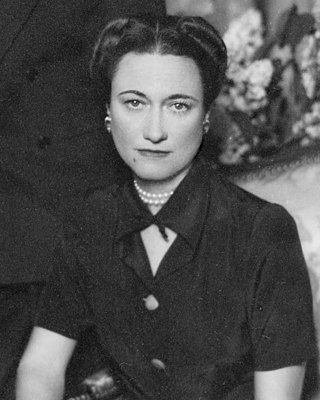
Wallis, Duchess of Windsor was an American socialite and wife of former king Edward VIII. Their intention to marry and her status as a divorcée caused a constitutional crisis that led to Edward's abdication.

Mary of Teck was Queen of the United Kingdom and the British Dominions, and Empress of India, from 6 May 1910 until 20 January 1936 as the wife of King-Emperor George V.

Princess Helena Victoria of Schleswig-Holstein, informally known by her family as Thora, was a granddaughter of Queen Victoria of the United Kingdom. From July 1917, she was addressed simply as Princess Helena Victoria.
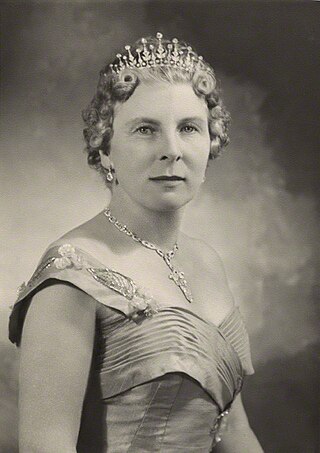
Lady May Helen Emma, Lady Abel Smith was a member of the British royal family. On her mother's side she was a great-granddaughter of Queen Victoria and on her father's side she was a great-great-granddaughter of King George III and the niece of Queen Mary, wife of King George V and mother of two kings. She led a private life in Britain. From 1958 until 1966, she lived in Brisbane, while her husband, Sir Henry Abel Smith, served as the governor of Queensland.
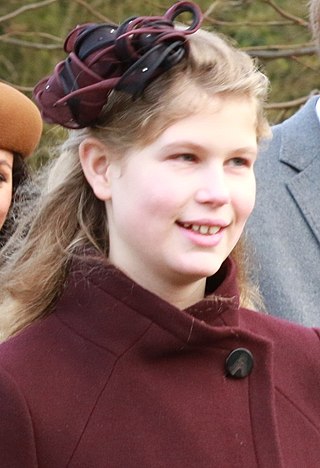
Lady Louise Alice Elizabeth Mary Mountbatten-Windsor is the daughter of Prince Edward, Duke of Edinburgh, and Sophie, Duchess of Edinburgh. She is a granddaughter of Queen Elizabeth II, and the youngest niece of King Charles III. Born 8th in line to the British throne, she is now 16th.

Frogmore is an estate within the Home Park, adjoining Windsor Castle, in Berkshire, England. It comprises 33 acres (130,000 m2), of primarily private gardens managed by the Crown Estate. It is the location of Frogmore House, a royal retreat, and Frogmore Cottage. The name derives from the preponderance of frogs which have always lived in this low-lying and marshy area near the River Thames. This area is part of the local flood plain. Its large landscaped gardens are Grade I listed on the Register of Historic Parks and Gardens.

Princess Louise Margaret of Prussia, later Duchess of Connaught and Strathearn, was a member of the House of Hohenzollern who married into the British royal family. She served as the viceregal consort of Canada while her husband, Prince Arthur, Duke of Connaught and Strathearn, served as the governor general, from 1911 to 1916.

The Royal Burial Ground is a cemetery used by the British royal family. Consecrated on 23 October 1928 by the Bishop of Oxford, it is adjacent to the Royal Mausoleum, which was built in 1862 to house the tomb of Queen Victoria and Prince Albert. The burial ground lies on the Frogmore estate within the Home Park at Windsor, in the English county of Berkshire.

Edward VIII, later known as the Duke of Windsor, was King of the United Kingdom and the Dominions of the British Empire, and Emperor of India, from 20 January 1936 until his abdication in December of the same year.
Honouring individuals buried in Westminster Abbey has a long tradition. Over 3,300 people are buried or commemorated in the abbey. For much of the abbey's history, most of the people buried there besides monarchs were people with a connection to the church – either ordinary locals or the monks of the abbey itself, who were generally buried without surviving markers. Since the 18th century, it has become a prestigious honour for any British person to be buried or commemorated in the abbey, a practice much boosted by the lavish funeral and monument of Isaac Newton, who died in 1727. By 1900, so many prominent figures were buried in the abbey that the writer William Morris called it a "National Valhalla".

St George's Chapel at Windsor Castle in England is a castle chapel built in the late-medieval Perpendicular Gothic style. It is a Royal Peculiar, and the Chapel of the Order of the Garter. St George's Chapel was founded in the 14th century by King Edward III and extensively enlarged in the late 15th century. It is located in the Lower Ward of the castle.

In the United Kingdom, state funerals are usually reserved for monarchs. The most recent was the state funeral of Queen Elizabeth II on 19 September 2022.

Victoria, Queen of the United Kingdom of Great Britain and Ireland and Empress of India, died on 22 January 1901 at Osborne House on the Isle of Wight, at the age of 81. At the time of her death, she was the longest-reigning monarch in British history. Her state funeral took place on 2 February 1901, being one of the largest gatherings of European royalty.

On 6 February 1952, George VI, King of the United Kingdom, died at the age of 56, at Sandringham House, after a prolonged cancer. His state funeral took place on 15 February 1952. A period of national mourning commenced and his eldest daughter and successor, Queen Elizabeth II was proclaimed the new monarch by the Accession Council. George VI's coffin lay in St Mary Magdalene Church, Sandringham until 11 February when it was carried, in procession, to the nearby Wolferton railway station. The coffin was carried by train to London King's Cross railway station where another formal procession carried it to Westminster Hall where the king lay in state for three days. Some 304,000 people passed through Westminster Hall with queues up to 4 miles (6.4 km) forming.
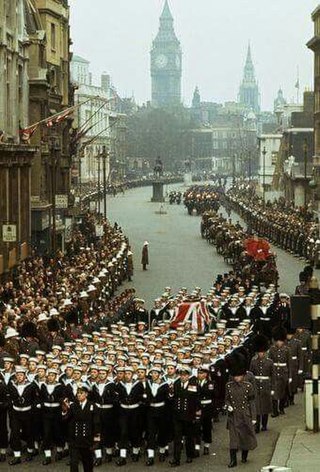
The Royal Navy State Funeral Gun Carriage is a converted Ordnance, BL, 12 pdr 6 cwt, MK II, gun carriage which has been used in the UK to bear the coffin at the funeral processions of: Queen Victoria; King Edward VII; King George V; King George VI; Sir Winston Churchill; Admiral of the Fleet The 1st Earl Mountbatten of Burma; and Queen Elizabeth II. It is traditionally pulled by members of the Royal Navy; when not in use, it is kept at the shore establishment HMS Excellent. A smaller version, known as the Portsmouth Gun Carriage, has been used at the ceremonial funerals of several senior naval officers in the 20th century.

The King George VI Memorial Chapel is part of St George's Chapel at Windsor Castle in England. The chapel was commissioned by Elizabeth II in 1962 as a burial place for her father, George VI, and was completed in 1969. It contains the final resting places of King George VI, Queen Elizabeth The Queen Mother, Queen Elizabeth II, Prince Philip, Duke of Edinburgh, and the ashes of Princess Margaret. It was designed by George Pace.

George V, King of the United Kingdom and the British Dominions, and Emperor of India, died at the Sandringham House in Norfolk on 20 January 1936, at the age of 70. He was succeeded by the eldest son, Edward VIII, who abdicated that year.
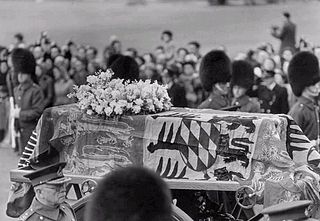
The funeral of Queen Mary, widow to King George V, took place on 31 March 1953 at St George's Chapel, Windsor Castle, following her death on 24 March and subsequent lying in state at Westminster Hall. Her death occurred two months short of her 86th birthday and ten weeks before the coronation of her granddaughter, Queen Elizabeth II.

The funeral of Wallis, Duchess of Windsor, took place on April 29, 1986. Wallis was the widow of Prince Edward, Duke of Windsor, who had been King of the United Kingdom from January 20 to December 11, 1936, reigning as Edward VIII before his abdication to marry Wallis, a divorcée. She was living in Paris at the time of her death. Her funeral took place at St George's Chapel in Windsor Castle and she was buried next to her husband at the Royal Burial Ground at Frogmore.

The funeral of Queen Alexandra, widow to King Edward VII and mother to King George V, occurred on Friday, 27 November 1925 at Westminster Abbey, following her death on 20 November.




















